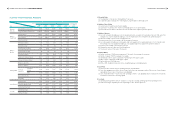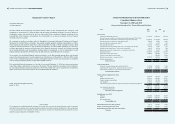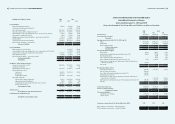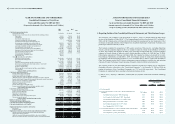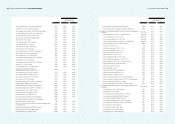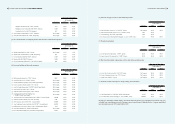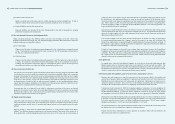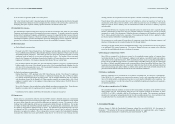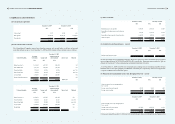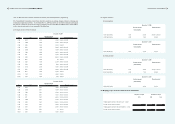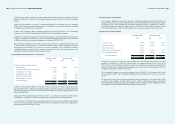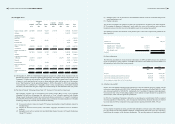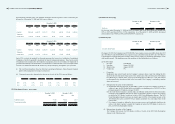Acer 2010 Annual Report Download - page 44
Download and view the complete annual report
Please find page 44 of the 2010 Acer annual report below. You can navigate through the pages in the report by either clicking on the pages listed below, or by using the keyword search tool below to find specific information within the annual report.
ACER INCORPORATED
2010 ANNUAL REPORT
84
FINANCIAL STANDING
85
2. Summary of Signicant Accounting Policies
(1) Accounting principles and consolidation policy
The consolidated financial statements are prepared in accordance with accounting principles generally
accepted in the Republic of China. These consolidated nancial statements are not intended to present the
nancial position and the related results of operations and cash ows of the Consolidated Companies based
on accounting principles and practices generally accepted in countries and jurisdictions other than the ROC.
The consolidated nancial statements include the accounts of the Company and subsidiaries in which the
Company is able to exercise control over the subsidiary’s operations and nancial policies. The operating
activity of the subsidiary is included in the consolidated statements of income from the date that control
commences until the date that control ceases. All signicant inter-company balances and transactions are
eliminated in consolidation.
(2) Use of estimates
The preparation of the accompanying consolidated financial statements requires management to make
estimates and assumptions that affect the reported amounts of assets and liabilities and disclosures of
contingent assets and liabilities at the date of the consolidated nancial statements and reported amounts of
revenues and expenses during the reporting periods. Economic conditions and events could cause actual
results to differ signicantly from such estimates.
(3) Foreign currency transactions and translations
The Company’s reporting currency is the New Taiwan dollar. The Consolidated Companies record
transactions in their respective local currencies of the primary economic environment in which these entities
operate. Non-derivative foreign currency transactions are recorded at the exchange rates prevailing at the
transaction date. At the balance sheet date, monetary assets and liabilities denominated in foreign currencies
are translated into New Taiwan dollars using the exchange rates on that date. The resulting unrealized
exchange gains or losses from such translations are reflected in the accompanying statements of income.
Non-monetary assets and liabilities denominated in foreign currency that are measured in terms of historical
cost are translated using the exchange rate at the date of the transaction. Non-monetary assets and liabilities
denominated in foreign currency that are measured at fair value are reported at the rate that was in effect
when the fair values were determined. Subsequent adjustments to carrying values of such non-monetary
assets and liabilities, including the effects of changes in exchange rates, are reported in prot or loss for the
period, except that if movement in fair value of a non-monetary item is recognized directly in equity, any
foreign exchange component of that adjustment is also recognized directly in equity.
In preparing the consolidated nancial statements, the foreign subsidiaries’ nancial statements are initially
remeasured into the functional currency and the remeasuring differences are accounted for as exchange gains
or losses in the accompanying statements of income. Translation adjustments resulting from the translation
of foreign currency financial statements into the Company’s reporting currency and a monetary item that
forms part of the Company’s net investment in a foreign operation are accounted for as cumulative translation
adjustment, a separate component of stockholders’ equity.
(4) Classication of current and non-current assets and liabilities
Cash or cash equivalents, and assets that will be held primarily for the purpose of being traded or are expected
to be realized within 12 months after the balance sheet date are classied as current assets; all other assets are
classied as non-current.
Liabilities that will be held primarily for the purpose of being traded or are expected to be settled within 12 months
after the balance sheet date are classified as current liabilities; all other liabilities are classified as non-current.
(5) Cash and cash equivalents
Cash and cash equivalents consist of cash on hand, cash in banks, miscellaneous petty cash, and other highly
liquid investments which do not have a signicant level of market or credit risk from potential interest rate
changes.
(6) Allowance for doubtful accounts
Allowance for doubtful accounts is provided based on the collectibility, aging and quality analysis of notes
and accounts receivable.
(7) Inventories
Effective January 1, 2009, the Consolidated Companies adopted the revised Republic of China Statement
of Financial Accounting Standards (SFAS) No. 10 “Accounting for Inventories”. The cost of inventories
comprises all costs of purchase and other costs incurred in bringing the inventories to their present location
and condition. Inventories are measured individually at the lower of cost and net realizable value. Cost of
inventory is determined using the weighted-average method. Net realizable value is determined based on the
estimated selling price in the ordinary course of business, less all estimated costs of completion and selling
expenses at the balance sheet date.
(8) Financial instruments
The Consolidated Companies adopted trade date accounting for nancial instrument transactions. At initial
recognition, nancial instruments are accounted for at fair value plus, in the case of a nancial instrument not
at fair value through prot or loss, transaction costs that are directly attributable to the acquisition or issue
of the financial instrument. Subsequent to initial recognition, financial instruments are classified into the
following categories in accordance with the purpose of holding or issuing of such nancial instruments:
(a) Financial assets/liabilities at fair value through prot or loss
An instrument is classied as nancial asset/liability reported at fair value through prot or loss if it is
held for trading or is designated as such upon initial recognition. Derivatives that do not meet the criteria
for hedge accounting are classified as financial assets or liabilities at fair value through profit or loss.
Financial instruments reported at fair value through prot or loss are measured at fair value, and changes
therein are recognized in prot or loss.
(b) Hedging derivative nancial assets / liabilities
Hedging derivative nancial assets / liabilities represent derivatives that are intended to hedge the risk of
changes in exchange rates resulting from operating activity transactions denominated in foreign currencies
and conform to the criteria for hedge accounting.
(c) Available-for-sale nancial assets
Available-for-sale nancial assets are measured at fair value and changes therein, other than impairment
losses and foreign exchange gains and losses on available-for-sale monetary items, are recognized as a
separate line item of stockholders’ equity. When an investment is derecognized, the cumulative unrealized
gain or loss recognized in equity is transferred to profit or loss. If there is objective evidence which
indicates that a nancial asset is impaired, a loss is recognized in prot or loss. If, in a subsequent period,
events or changes in circumstances indicate that the amount of impairment loss decreases, reversal of a
previously recognized impairment loss for equity securities is charged to equity; while for debt securities,
the reversal is allowed through prot or loss provided that the decrease is clearly attributable to an event
which occurred after the impairment loss was recognized.




